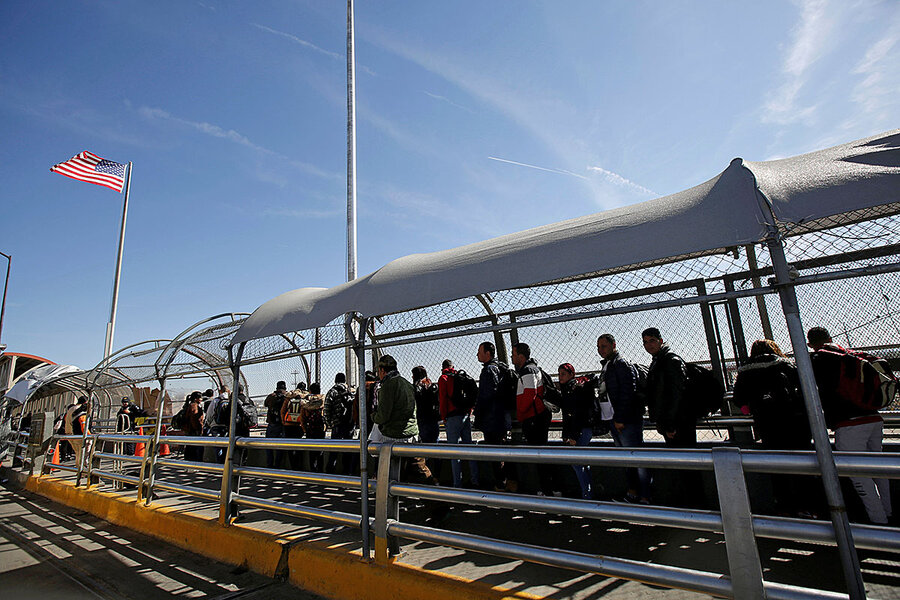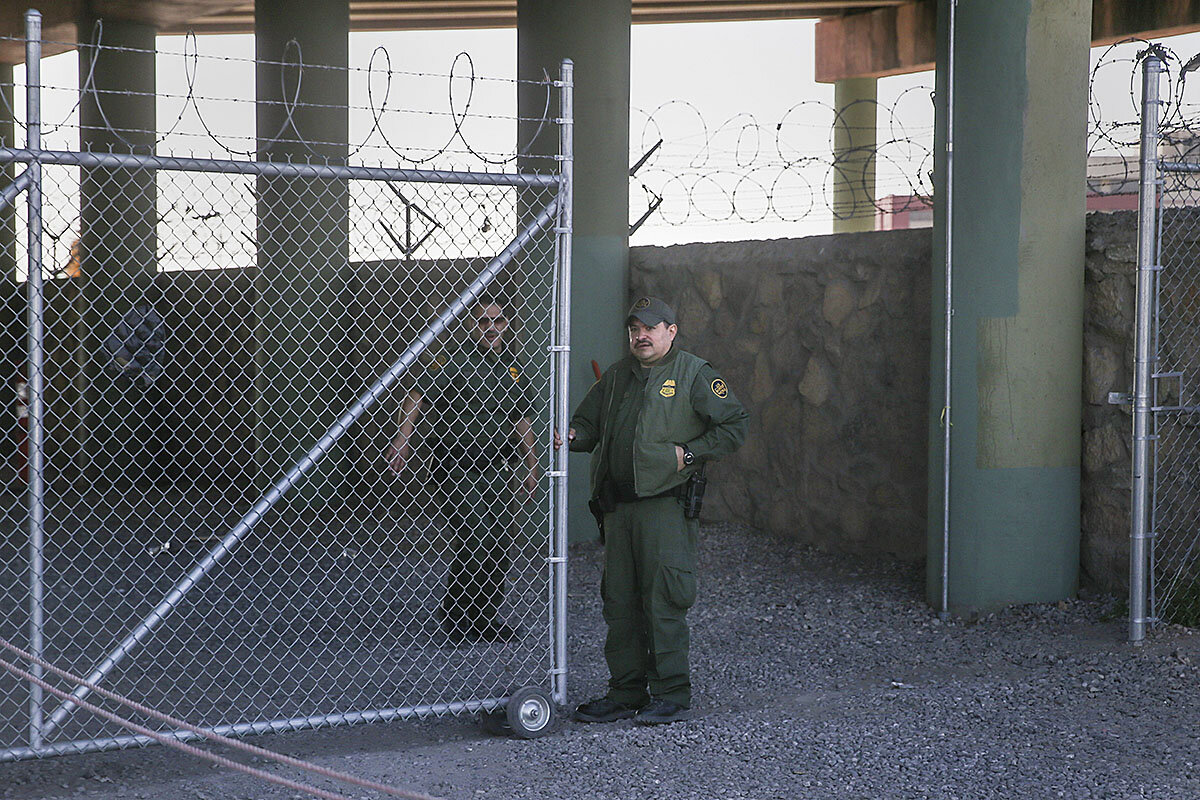Everyone agrees the US needs to fix the border. But how?
| El Paso, Texas
Xochitl Rodriguez crossed the Rio Grande a few weeks ago to visit her aunt’s old studio in Ciudad Juárez. It had been years since she had visited, her aunt having fled to El Paso a decade ago amid intensifying cartel violence.
Born and raised on the United States side of this binational metroplex, Ms. Rodriguez is no stranger to the six bridges that cross the Rio Grande. On her way back, she saw something she had never seen before: hundreds of migrants sleeping behind chain-link fencing under the Paso del Norte Bridge.
“Two hundred people and they were yelling up at us: ‘We’re already four days here in the dirt,’” she recalls. “How as a human do you allow that to happen?”
Why We Wrote This
Does a shift in thought have any chance against the reality of immigration as a political points-winner for hard-line sides? One source tells our writer that the key might be looking at border security as “an ecosystem,” with variables beyond those that are usually seen.
For months, asylum-seekers – predominantly families and unaccompanied children from Central America – have been arriving at southern border cities like El Paso in numbers not seen in a decade. Community members like Ms. Rodriguez have been working round the clock to help shelter and feed migrants released by overwhelmed immigration agencies.
“El Paso knows how to do it. I wish we didn’t know. I wish we didn’t have to do this,” she says. “From the perspective of this community, it’s especially frustrating to see no help and no real policy change.”
Immigration agencies are working around the clock as well, taking unprecedented steps in response to a migrant surge they say they are ill-equipped, physically and legally, to handle. Two children died in U.S. custody in December, and medical screenings are being conducted for every child under 17. Extra agents are being drafted in from across the southwest border to help process migrants, and wait times at ports of entry now last hours.
While immigration is a notoriously divisive political issue, the current crisis has reinforced a widespread consensus, stretching from federal agencies to immigrant activists, that America’s immigration system needs an overhaul. A tougher question is whether consensus can be found over what that overhaul should look like, particularly given how inaction has become a fruitful response for the politicians who would need to do the overhauling.
The issue with prioritizing changing laws, experts say, is that immigration has become a political wedge issue.
“Wedge issues don’t get resolved. They get used by both sides to mobilize their base,” wrote Sonia Nazario, a veteran immigration journalist, in a New York Times op-ed last October.
Border as an ‘ecosystem’
In addition to legal and policy changes to a system geared toward quickly deporting adult Mexican men, some experts believe a structural rethink is necessary.
“We’ve treated border security, really for the last 35 years, as the fence of a static line,” says Victor Manjarrez, a former Border Patrol sector chief.
“We should look at border security more of as an ecosystem,” he adds, “an ecosystem that is affected by a bunch of variables near and distant, things that border security folks don’t touch but certainly affects them.”
A shake-up in the higher ranks of the Department of Homeland Security (DHS) this month hints at how the Trump administration may now seek to plug what it calls “loopholes” in immigration law.
“The only way to fundamentally address these flows is for Congress to act and to reinstate integrity into our immigration system,” said Kevin McAleenan, commissioner of U.S. Customs and Border Protection (CBP), in a late-March press conference. Commissioner McAleenan is expected to become the agency’s acting secretary after a number of forced resignations last week.
Specifically, there are two areas of the law the Trump administration is seeking to change. A settlement in a 1997 class-action lawsuit called Flores requires the government to hold families for no longer than 20 days. In addition, the Trafficking Victims Protection Reauthorization Act (TVPRA), enacted in 2008, requires the government to put all unaccompanied migrant children into immigration court proceedings unless they’re from Mexico or Canada. The administration is also seeking to raise the standard by which an asylum-seeker can claim “credible fear,” The New York Times reports.
American and international asylum laws, combined with the likelihood of a quick release from detention via the Flores settlement and TVPRA and yearslong backlogs in U.S. immigration courts, form a relatively simple route to life in the U.S. for migrants until at least 2021. A majority of asylum claims are denied – around 60% in fiscal year 2017. That year, 11,022 migrants released from custody were ordered deported after failing to appear for their immigration court hearings, a 21% increase from the year before, according to the Justice Department.
The “border” could be pushed out, says Dr. Manjarrez, now a professor at the University of Texas, El Paso (UTEP), in terms of asylum-seekers being vetted before they arrive at the U.S. border and need to be housed or transported. Could credible fear claims be evaluated in the asylum-seekers’ home country? Could asylum cases be adjudicated in Mexico?
Such proposals would likely be challenged in court. American and international asylum laws are premised on the notion that refugees request asylum once they reach the refuge country because they are in too much danger elsewhere. Last week a federal judge in San Francisco temporarily blocked a DHS policy requiring asylum-seekers to wait in Mexico while their claims made their way through U.S. immigration court in part because it violated laws ensuring migrants “are not returned to unduly dangerous circumstances.”
Also likely to face court challenges is a plan the White House says it is mulling to release detained migrants in so-called sanctuary cities, many of which are Democratic strongholds. On Monday, the chairmen of three House committees asked the White House and agency officials for internal documents on those deliberations, according to The Associated Press.
‘The border story is the blowback’
Instead of tightening asylum requirements, or extending U.S. border control infrastructure into other countries, others believe the current immigration system could work provided it’s resourced appropriately. Just look at Annunciation House, a nonprofit in El Paso that has been sheltering migrants released by immigration agencies, says Ms. Rodriguez.
“If Annunciation House can process 700 people a day ... as an NGO with a minimal budget, a federal government can figure out how to do this,” she adds.
With the CBP budget having increased more than tenfold between 1990 and 2015, the government should be able to detain more asylum-seekers and hire more immigration judges so asylum claims can be adjudicated faster, says Josiah Heyman, director of the Center for Inter-American and Border Studies at UTEP.
“The border story is the blowback from an increasingly dysfunctional and failing immigration court system,” he says.
“The immigration judicial process needs to be quick, efficient, and fair,” he continues, and “everyone needs representation because if they did I think a lot of the inadequate cases would drop by the wayside.”
The CBP is planning to open a new migrant processing center in El Paso in April. Last week U.S. Attorney General William Barr told Congress the Department of Justice is requesting $72 million for 100 new immigration judges, though he also said that “the problem with the asylum laws” needs to be addressed first.
The blame game
The current crisis has been brewing for at least five years, when 2014 saw a surge in unaccompanied minors from Central America at the southern border. The situation has only become more complicated since then, experts say.
CBP announced last week that more than 103,000 migrants were apprehended or found inadmissible at the southern border in March, an increase from 76,500 in February. However, the number of arrested migrants with criminal convictions has been declining. The rise of sophisticated smuggling operations through Mexico and fears that President Donald Trump’s threats to close the border to everyone may actually be realized have supersized migrant flows, meaning those with weaker asylum claims, like economic migrants, are making the journey. But economic migrants can also be indirect victims of violence and government corruption in their countries.
“The dysfunctionality of the U.S. immigration system is something that goes way back,” says Guadalupe Correa-Cabrera, a professor at the George Mason University Schar School of Policy and Government. But “it seems like the Democratic Party, and Republicans and the Trump administration, they’re only blaming [each other].”
“This might be the end of an era,” she says, referring to the ousters at DHS. “What we might see now is a real attempt to address the issues that need to be addressed.”








